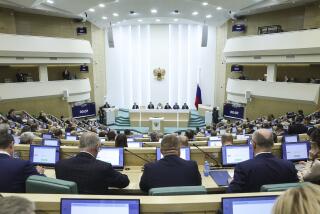U.S.-Soviet Meeting on Verifying A-Tests Starts
- Share via
GENEVA — Talks began here Friday between the United States and the Soviet Union on nuclear testing and how to strengthen means of seismic verification of underground nuclear explosions, the first such talks since the Reagan Administration took office more than five years ago.
Although the discussions are strictly technical, at least as far as the United States is concerned, they could produce the first steps toward a new superpower agreement in the test ban field.
Heading the American delegation of about a dozen experts is Robert B. Barker, deputy assistant director of the Arms Control and Disarmament Agency. Andronik M. Petrosyants, chairman of the Soviet state atomic energy committee, heads the Soviet side.
The two delegation chiefs held a brief morning session at the U.S. mission to discuss procedures for the talks, which are expected to last at least through next week. They got down to business with a two-hour afternoon meeting. There was no news briefing or further information on the substance of the discussions.
Meanwhile, there was a recess Friday in the second set of U.S.-Soviet discussions here, on compliance with the unratified 1979 strategic arms limitation treaty. President Reagan has said he is ready to abandon the treaty before the end of the year. In these talks, both sides are now awaiting further instructions from their capitals, and the meetings, chaired by U.S. and Soviet generals, are also expected to last through next week.
Insistance on Verification
Although the Soviet Union is currently observing a unilateral moratorium on all nuclear testing and is pressing the United States to join in a total test ban, the American side is insisting that an agreed system of seismic verification must be established along with a system of on-site inspections of any suspicious seismic incidents.
More than 12 years ago, the two superpowers, along with Britain, negotiated a limited test ban treaty that puts a ceiling of 150 kilotons on underground nuclear explosions, but this has never been ratified by either side. The Reagan Administration contends that the Soviet Union has violated the 150-kiloton limit on several occasions, although this has never been conclusively proven. (One kiloton is the equivalent of the explosion of 1,000 tons of TNT).
However, the science of seismic instrumentation and readings has now advanced to a point where it is not only possible to make accurate readings of underground nuclear explosions but even to differentiate between the tremors of nuclear and conventional explosions.
Moreover, the Soviet Union earlier this month permitted an unofficial team of U.S. scientists from a private organization, the Natural Resources Defense Council, to install about a dozen seismic devices in the rugged remote hills of Kazakhstan in the vicinity of the Soviet test site at Semipalatinsk. A team of Soviet scientists is expected to be permitted to set up similar devices in the vicinity of the U.S. test site in Nevada before the end of the year.
Soviets ‘Favor’ Verification
At a meeting last Tuesday in Geneva of the 40-nation U. N. Conference on Disarmament, Soviet Ambassador Viktor L. Issraelyan said, “We have repeatedly stated that the Soviet Union is open for verification of non-carrying out of nuclear explosions, is in favor of the most strict verification including on-site inspections and the use of all achievements of seismology.”
In the face of this activity, experts here say it is increasingly likely that the experts here may be able to reach an agreement on at least the outline of the seismic instruments that could be installed on both Soviet and U.S. territory. Such an agreement could then be approved at summit meeting between President Reagan and Soviet leader Mikhail S. Gorbachev, now expected to take place in November or December.
This is the first face-to-face superpower discussion of the test ban problem since negotiations on a comprehensive test ban treaty recessed in 1980, before the Reagan Administration took office.
More to Read
Sign up for Essential California
The most important California stories and recommendations in your inbox every morning.
You may occasionally receive promotional content from the Los Angeles Times.













